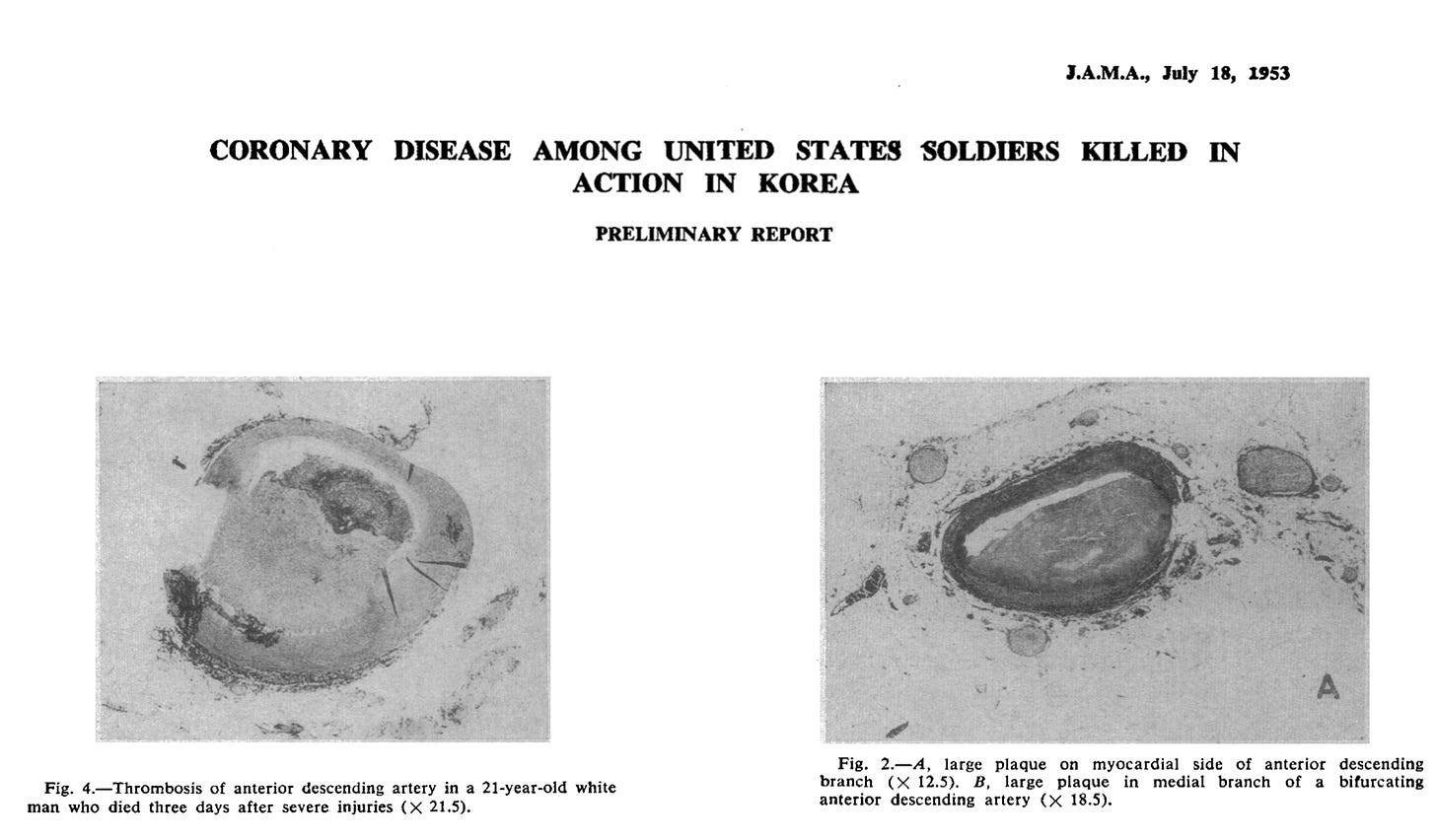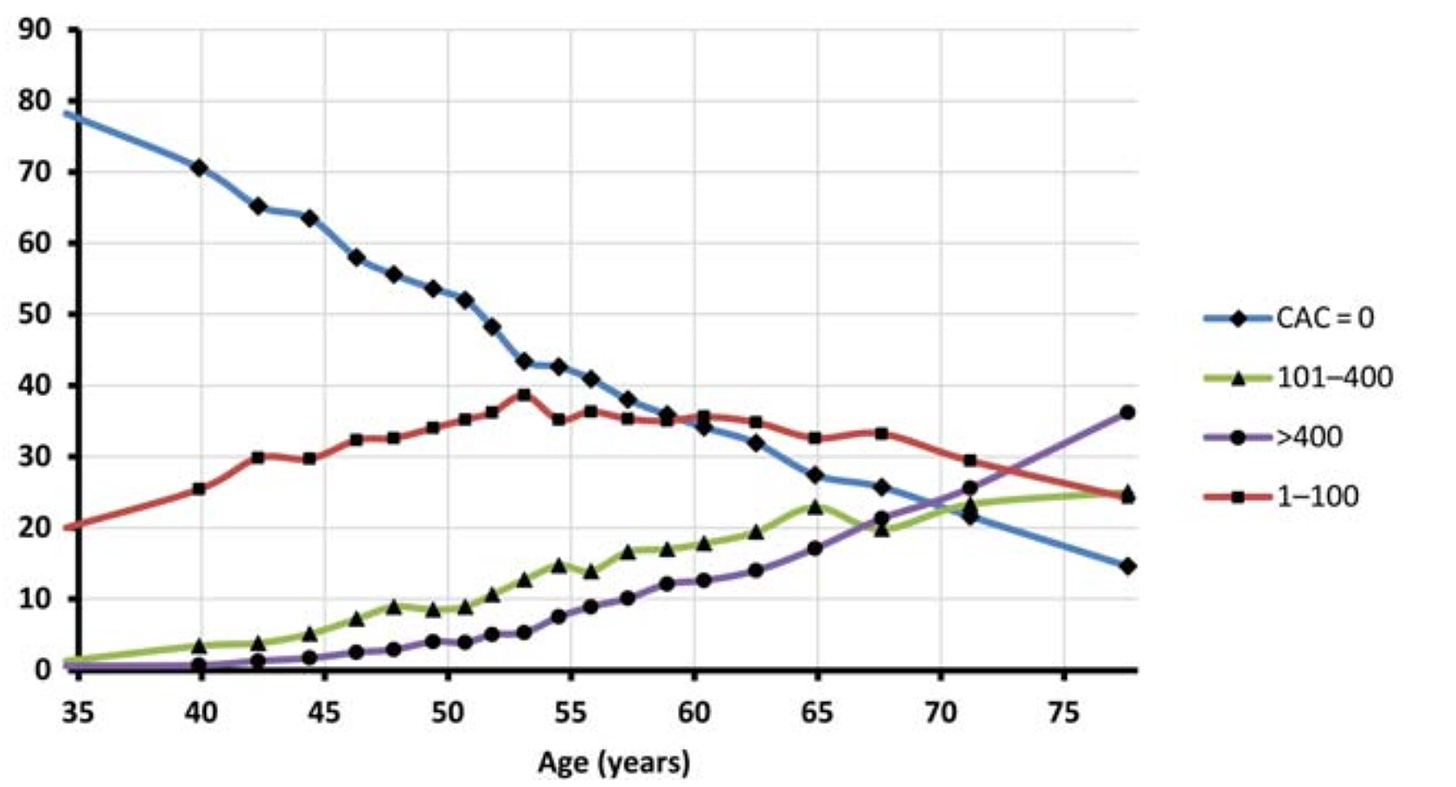The Clock Is Ticking: Why You Likely Already Have Coronary Artery Disease

The young, not the old, need to think most about cardiovascular risk.
The older you get, the greater your risk of having a heart attack.
No surprises there.
But let’s dig a little deeper.

As you can see from the above graph, those aged over 85 years of age have the highest incidence of cardiovascular events.
Very much as expected.
But now, let’s look at things differently. By the percentage of total events in each age category.

Over 50% of all heart attacks in males happen before they reach 65 years of age. For females, that number is about 30%.
I suggest you go back and reread that last sentence and let those figures sink in.
But wait. It’s the older people who have all the heart attacks?
Why the difference between the two graphs?
The reality is there are just significantly more people alive under the age of 65 compared to those older than 65. It comes down to the fact that a small percentage of a very big number is always a big number.

In the age category 45-54 years of age alone, there are about 23 million males and 22 million females. Compare that to the number of males and females aged 85 and above—a combined figure of less than 3 million.
So yes. The probability of an 85-year-old having a heart attack is much higher than a 65-year-old, but there are just far fewer 85-year-olds alive to have them. And with even a small percentage of adults under 65 having heart attacks, the absolute number is still very high. It’s a numerator and denominator issue.
Knowing this should unnerve you.
It unnerved me.
A person has a heart attack because a plaque (atherosclerosis) in their artery ruptures, causing a clot to form and suddenly stop blood flow to the heart.

However, the atherosclerosis that caused the heart attack had been building up for a long time.
Most likely for years. If not decades.
And that plaque may have already ruptured several times before causing a heart attack. This is the likely mechanism of how plaques in the artery progressively narrow.
The savvy readers among you will now be doing some simple math;
“If lots of people have heart attacks at less than 65 years of age and the atherosclerosis that caused it has been building up for many years before that, then the process of atherosclerotic plaque build-up must have started at a VERY young age?”
You would be right. And we have known this for at least 70 years.
This is why young people should be so concerned about heart disease.
Let’s look at some more evidence.
This time in young people.
Very young people.

The images above show autopsy sections of the coronary arteries of soldiers killed in combat during the Korean War. Of the 200 autopsies performed, 77% had some ‘evidence of coronary atherosclerosis’ identified.
The average age of these soldiers? 22 years of age.
Many of these cases demonstrated only mild thickening of the artery wall. But some of the cases revealed far greater deposits of atherosclerosis. None of these patients died from coronary artery disease. They all died with coronary artery disease.
Smoking rates were much higher in the 1950s during the Korean War, and maybe that’s what accounts for these changes? Smoking was a likely contributor so let’s look at some more recent findings.

The above graph shows the prevalence of coronary artery atherosclerosis in 262 healthy heart transplant donors. None of these had known heart disease before being considered for heart transplant donation. This data was collected during the 1990s, when smoking rates in the general population had reduced dramatically compared to the 1950s.
Significant atherosclerosis was identified in 52% of cases.
The average age of these donors? 33 years of age.
But it gets worse.

What you are looking at are the very earliest changes of atherosclerosis seen in the coronary arteries of infants who sadly died of sudden infant death.
What all of this amounts to is that coronary artery atherosclerosis, the critical ingredient of heart attacks, is building up in our coronary arteries from the earliest moments of our lives.
But although we start accumulating atherosclerosis from a very young age, does it progress significantly in everyone?
And do some people ultimately avoid coronary disease?
Let’s look at coronary artery calcium scores across different age categories. Coronary artery calcification is a feature of more advanced coronary atherosclerosis detected non-invasively using a standard CT scanner.
Everyone starts with a score of zero—i.e. No calcified plaque.
We know that a higher number equals more atherosclerotic plaque.
More plaque equates to higher risk.

As you can see from the red line in the graph above, by age 40, about 25% of people will have at least some plaque. What we call a ‘non zero’ score. i.e.>1.
From the blue line, we can see that only about 15% of people will have a score of 0 in their mid to late 70s. A finding is typically associated with a low risk of heart events over a 10-year period.
It is also important to note that having visible coronary artery calcification means that the plaque in the artery has progressed significantly, and the calcium is likely a marker of repair to an advanced lesion.
Calcium is not a feature of early-stage plaque. It is a feature of late-stage plaque.
Even those with calcium scores of zero likely have the early stages of plaque buildup. It’s just that the tests we typically use do not see that plaque.
What are we to make of all this information?
-
Coronary artery atherosclerosis starts forming at a very young age. For some, even during infancy.
-
Given a long enough time horizon, almost everyone will develop a significant amount of coronary artery atherosclerosis and, therefore, a higher risk of a heart attack. Even the luckiest among us will succumb to significant atherosclerosis, but maybe that might require living to 150 years of age before it does.
-
Because plaque build-up starts early and is progressive, thinking about decreasing your cardiovascular risk should begin at a very early age, not just before you are thinking about retirement.
This is, of course, if your objective is to try and decrease your cardiovascular risk and live a long and healthy life.
Some people, however, wish to live Hunter S Thompson-style lives and arrive at the pearly gates by skidding in
“broadside in a cloud of smoke, thoroughly used up, totally worn out, and loudly proclaiming ", Wow! What a Ride!”
And if that is what you desire, I think the world is a more colourful place with people like you in it.
But if Hunter S Thompson style arrivals do not take your fancy, we have to consider cardiovascular risk from a very young age.
Decreasing that risk is a journey of a lifetime.
Because a lifetime is all, we get.




